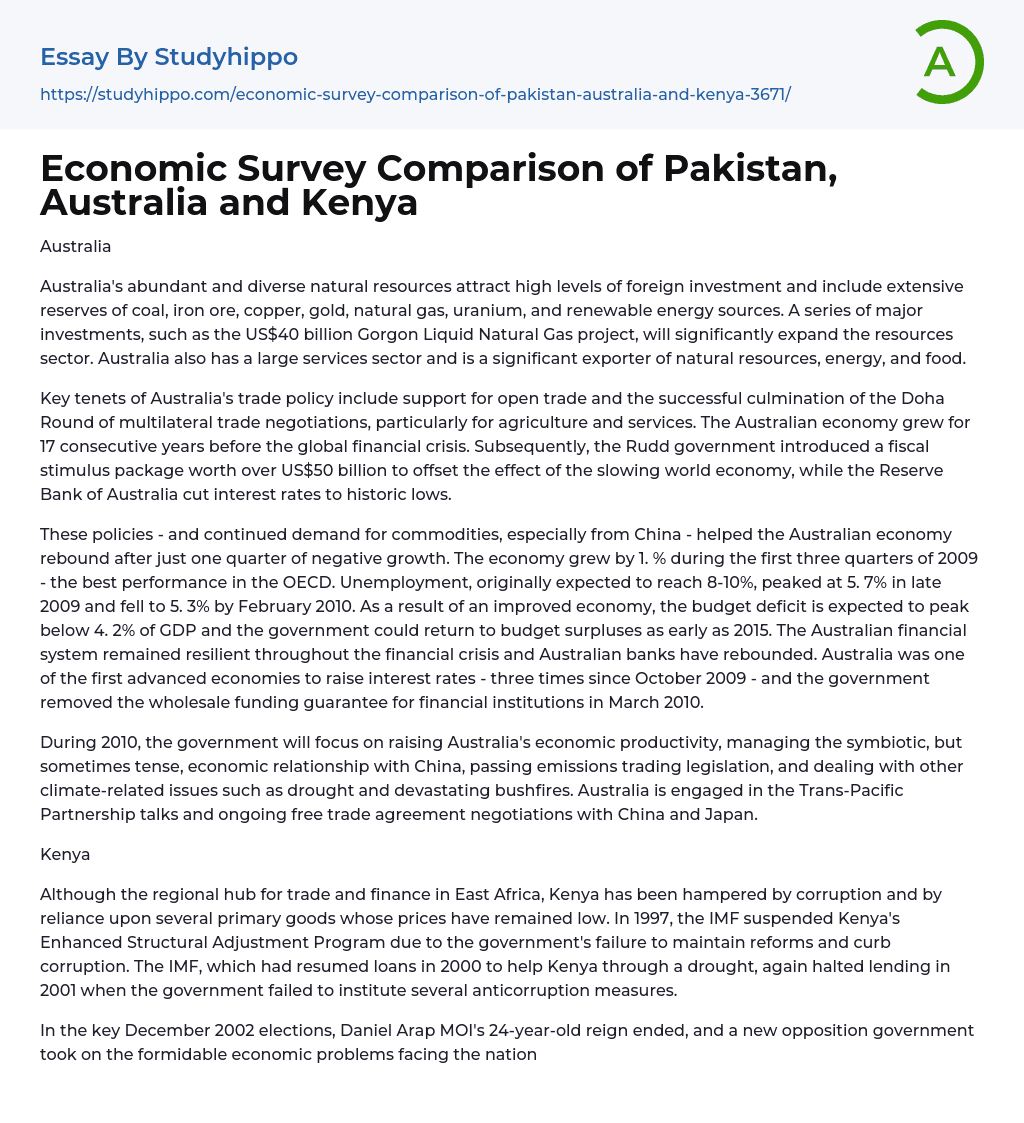

Economic Survey Comparison of Pakistan, Australia and Kenya Essay Example
Australia
is a nation that entices substantial foreign investment due to its ample and varied natural resources. These valuable reserves include coal, iron ore, copper, gold, natural gas, uranium, and renewable energy sources.
Australia's resources sector is set to experience substantial growth due to major investments like the US$40 billion Gorgon Liquid Natural Gas project. Additionally, Australia has a significant services sector and serves as an important exporter of natural resources, energy, and food. The country's trade policy actively promotes open trade and aims to successfully finalize the Doha Round of multilateral trade negotiations, especially in agriculture and services. Prior to the global financial crisis, Australia had a remarkable 17-year period of economic expansion.
The Rudd government responded to the global economic slowdown by implementing a fiscal stimulus package valued at over US$50 billio
...n. At the same time, the Reserve Bank of Australia reduced interest rates to historically low levels. These measures, combined with consistent demand for commodities, especially from China, resulted in a quick recovery for the Australian economy after only one quarter of contraction. Between Q1-Q3 2009, the economy achieved a growth rate of 1%, which was the highest among OECD countries. Unemployment, initially predicted to reach 8-10%, reached its peak at 5%.
The budget deficit in late 2009 was 7%, but it decreased to 5.3% by February 2010 thanks to economic improvement. Projections indicate that the budget deficit will peak below 4.2% of GDP, and the government may start experiencing budget surpluses again by 2015.
In terms of the Australian financial system, it has demonstrated resilience during the financial crisis and its banks have successfully recovered. Notably, interest rates in Australia were raised on three occasion
since October 2009, positioning it as one of the first advanced economies to take such action. In March 2010, the government also eliminated the wholesale funding guarantee for financial institutions. Moving forward into 2010, key priorities for the government include enhancing Australia's economic productivity, effectively managing its economic relationship with China, implementing emissions trading legislation, and addressing climate-related concerns like drought and bushfires. Furthermore, Australia is engaged in discussions regarding the Trans-Pacific Partnership and ongoing free trade agreement negotiations with China and Japan.
Kenya
Despite serving as a regional hub for trade and finance in East Africa, Kenya has encountered difficulties stemming from corruption issues and heavy reliance on primary goods that possess low price levels.
The IMF suspended Kenya's Enhanced Structural Adjustment Program in 1997 due to the government's failure to maintain reforms and curb corruption. They resumed loans in 2000 to help Kenya through a drought but halted lending again in 2001 when the government failed to implement anticorruption measures. In the crucial December 2002 elections, Daniel Arap MOI's 24-year reign came to an end, and a new opposition government took on the challenging economic problems facing the nation. The KIBAKI government initially made progress in combating corruption and gaining donor support, but was later hit by high-level graft scandals in 2005 and 2006. In response, the World Bank and IMF postponed loans until the government took action against corruption.
Despite the government's inaction against corruption, international financial institutions and donors have resumed lending. In early 2008, there was violence following the election, which, along with the impact of the global financial crisis on remittance and exports, led to a decline in estimated GDP growth to
2% or lower in 2008 and 2009.
Pakistan
Pakistan has long suffered from internal political disputes and low foreign investment due to its impoverished and underdeveloped status. However, between 2001-07, poverty levels decreased by 10% as Islamabad consistently increased development spending.
From 2004 to 2007, the industrial and service sectors fueled a GDP growth of 5-8%, even in the face of electricity shortages. However, there was a decline in growth during 2008-09 that led to increased unemployment rates. The public became greatly concerned about inflation, which rose from 7.7% in 2007 to a peak of 20.3% in 2008 before eventually stabilizing at 14%.
Pakistan's economy saw a 2% decline in 2009, and the value of the Pakistani rupee has also decreased since 2007 due to political and economic instability. To address a balance of payments crisis, the government entered into an International Monetary Fund Standby Arrangement in November 2008. However, in 2009, there was improvement in the current account and stabilization of foreign exchange reserves as a result of lower oil prices and a significant increase in remittances from overseas workers.
Despite textiles being Pakistan's main export earner, the country's lack of diversification in its export base for other manufactured goods leaves it susceptible to fluctuations in global demand. Additionally, long-term challenges include the need for increased investment in education, healthcare, and electricity production as well as reduced dependence on foreign assistance.
- Australian Culture essays
- Agriculture essays
- Albert einstein essays
- Animals essays
- Archaeology essays
- Bear essays
- Biology essays
- Birds essays
- Butterfly essays
- Cat essays
- Charles Darwin essays
- Chemistry essays
- Dinosaur essays
- Discovery essays
- Dolphin essays
- Elephant essays
- Eli Whitney essays
- Environmental Science essays
- Evolution essays
- Fish essays
- Genetics essays
- Horse essays
- Human Evolution essays
- Isaac Newton essays
- Journal essays
- Linguistics essays
- Lion essays
- Logic essays
- Mars essays
- Methodology essays
- Mineralogy essays
- Monkey essays
- Moon essays
- Mythology essays
- Noam Chomsky essays
- Physics essays
- Plate Tectonics essays
- Progress essays
- Reaction Rate essays
- Roman Numerals essays
- Scientific essays
- Scientific Method essays
- Scientist essays
- Seismology essays
- Space Exploration essays
- Stars essays
- Sun essays
- Thomas Edison essays
- Tiger essays
- Time Travel essays



